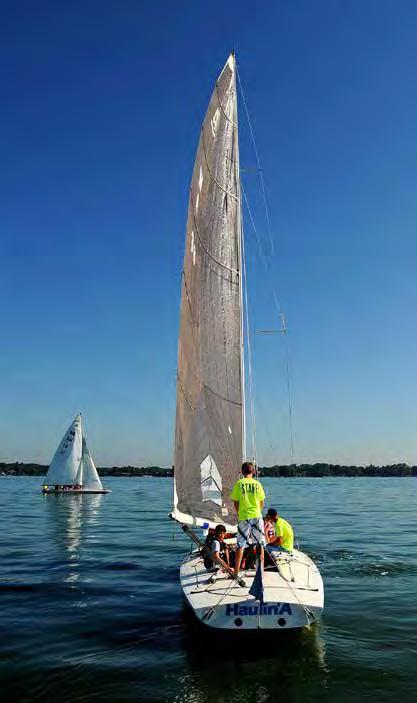
3 minute read
Water Fun
Shutterstock.com
Paddle Power
by John C. Gill
Using rhythmic movements, paddlers glide over the water, serenaded by the resulting wake.
Paddling evokes images of earlier times, when explorers in hand-hewn canoes navigated unfamiliar waterways. Though the time-honored canoe remains a popular non-motorized option, today’s paddlers also mount boards or kayaks to traverse lakes and negotiate rivers and streams. With acres of water and miles of shoreline to investigate, Kosciusko County provides the perfect setting for paddling.
Canoeists, kayakers, and paddleboarders, unlike most power boaters, have the ability to access tight areas and shallow water. They travel under their own power and at their own pace, directing the craft wherever curiosity leads them. This eco-friendly sport not only eliminates the need for purchasing gasoline, but also promotes physical fitness. Some users paddle fast and hard, while others prefer a slow and gentle pace. Paddlers may also vary the reach and style of their strokes and introduce additional exercises to their routines. For every technique and level of interest, paddling ensures a suitable watercraft.
Canoes
Anglers, campers, and day-trippers who travel with gear often choose a canoe as their manner of transport. Commonly constructed of polyethylene or fiberglass, and available in 12’ to 17’ lengths, canoes feature raised seating and offer ample cargo space. Ideal for family outings, a canoe will accommodate several individuals or pets in its belly.

Shutterstock.com
Kayaks
Lightweight and versatile with a lower center of gravity, kayaks are designed for solo or duo venturing, with tandem recreational kayaks representing a growing segment of the market. Using a double bladed paddle, kayakers rotate their torsos to propel the craft. Anglers sometimes favor pedal kayaks, which rely on pedal propulsion for forward or reverse motion. This gives them the freedom to cast fishing lines while moving about.
Easy to transport and excellent for sightseeing, kayaks position the paddler close to the water’s surface for a unique perspective. They are typically constructed of rotomolded plastic and range in length from 8’ to 13’. Shorter kayaks offer ease of control and quick turning. But paddlers in search of straight-line travel and speed seek longer models. Although less spacious than canoes, most kayaks provide small storage compartments in the cockpit plus topside straps for securing lifejackets, fishing poles, or coolers.
Paddleboards
For multifunctional applications, the paddleboard reigns as champion. Riders may stand, sit, or kneel on their boards while paddling, to focus on strengthening different muscle groups. They roll off to swim, then remount with ease. Paddlers fish from their boards, and use them for practicing yoga and tai chi.
The fastest paddleboards are narrow and made of fiberglass or carbon fiber. But for all-around recreational use, paddlers choose wider, PVC coated boards. The height of the rider determines the size of the board. A 7’ to 9’ board fits most children, while 11’ to 12’ lengths suit an adult.
Despite appearing precarious to onlookers, paddleboarding becomes second nature quickly. Riders from ages eight to 80 discover that balance kicks in after bending the knees upon mounting. Then strong, long, and leveraged reaches with each paddle stroke builds speed. If paddling into the wind becomes tiresome, riders sit or kneel on their boards to improve aerodynamics.
Paddles
As paddles are paramount to piloting canoes, kayaks and boards, riders need to determine the proper fit. The length of the paddle must correlate to the height or wingspan of the rider. Carbon fiber or graphite paddles enhance speed, as users expend less strength moving them through the water. A popular choice for recreational use is the lightweight and adjustable aluminum paddle with plastic blade, which allows for custom sizing.
Over the thousands of years since humans first piloted dugout canoes, boaters and engineers have perfected the paddle’s design. Today, as riders orchestrate their own maneuvers aboard manual-powered vessels, they continue to preserve the ancient activity of paddling.
Where to go
Bart’s Water Sports
Paddleboard and kayak sales + accessories
7581 800 N. North Webster 574.834.7666
bartswatersports.com
The Lake House Surfshop & Water Sports Store
Paddleboard and kayak sales and rentals + accessories Delivery and pick-up of rentals available 720 E. Canal Street Winona Lake 574.265.6945
lakehousesurf.com
Pedals & Paddles
Paddleboard and kayak sales and rentals + accessories 105 E. Esterbrook Dr. North Webster 574.244.2279










